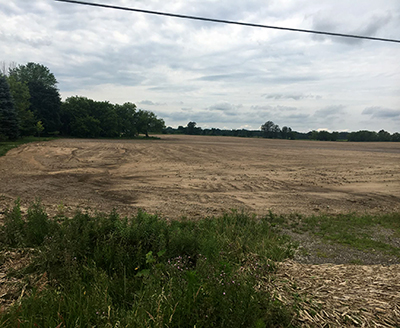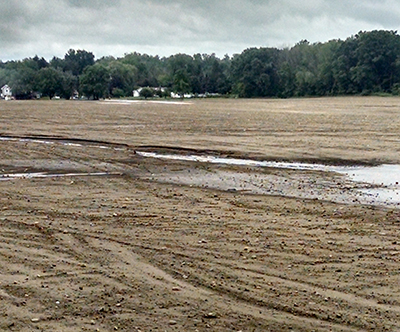Repairing your flood-damaged fields
Management options for restoring productivity in flood-damaged areas.

Heavy rains and flooding have left many farm fields in need of physical repair. Flood waters erode exposed soils, leaving deep gullies, drifted crop residue, brush and building materials, as well an assortment of other types of debris. In addition, this debris may be plugging your drainage systems.
Along with debris, the flood waters may have deposited sand and silt drifts that could vary from just a few inches to nearly 1 foot deep.
What to do first: Assess and map, preferably with GPS, damage types and locations
- Check for exposed utility lines such as electric or communication.
- Remove the larger debris.
- Check tile outlets and tubes for obstructions.
- Check for plugged risers and breathers.
- Check for holes or broken tiles, especially in growing crops. Large holes can be a hazard during field operations.
- Prioritize repairs and address safety concerns first, followed by those that are easy fixes and facilitate harvest. Some repairs can wait for post-harvest.
Drifted crop residue (free from trash) that is greater than 4 inches thick should be spread in a thin layer before incorporating. Incorporating large amounts of residue may have to wait until post-harvest; consider the cost and benefit of managing residue while in season.
Residue less than 4 inches thick can be incorporated with tillage. When incorporating large amounts of plant material, consider the additional nitrogen demand that will be caused by decomposing plant materials in those areas.

Field erosion caused by flooding. Photo by Monica Jean, MSU Extension.
In areas where the flood water left sand and silt, drifts that are less than 2 inches may be successfully mixed into the soil with normal tillage. Deposits 2 to 8 inches can be incorporated with a chisel plow, moldboard plow or other aggressive tillage tool.
When deposits are deeper than 8 inches, other types of earth-moving equipment may be necessary to uniformly spread soil across the field.
In areas where the running water caused gully erosion, repair will be necessary. Shallow erosion may be repaired with tillage. Deeper erosion may require some type of earth-moving equipment for proper land leveling.
Be cautious using the drifted sand and silt when filling the eroded gully’s unless you can place topsoil over the top. The sand has very little water-holding capacity and is very likely to erode quickly in another severe rain event.

Gully created by large amount of rain in farm fields will need repair. Photo by Paul Gross, MSU Extension.
Fertility and soil health are also a concern when areas of fields are flooded. Soil microbiology changes because of flooding, commonly referred to as flooded soil syndrome. Flooded soil syndrome is the loss of beneficial fungi that mobilize soil-based plant nutrients. The fungi (arbuscular mycorrhizae) penetrate roots, receiving carbohydrates and giving the plant nutrients.
Consider soil testing and proper fertilization in these areas, especially if the areas are a larger percentage of the field.
If these areas are consistently subject to this type of erosion, consider grass waterways and cover crops for a long-term solution. Cover crops also add organic matter to soil while stimulating microbial and fungal activity.
For more information on cover crop selection, visit the cover crop decision tool and other cover crop resources on the Midwest Cover Crops Council website.
For more information on managing water- and storm-damaged fields from Michigan State University Extension:



 Print
Print Email
Email